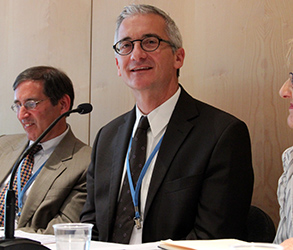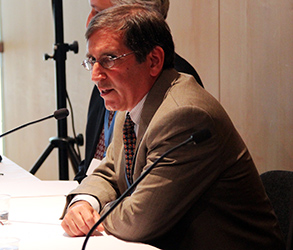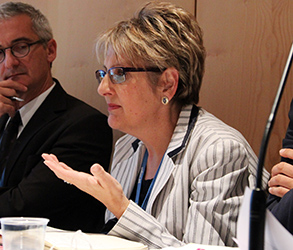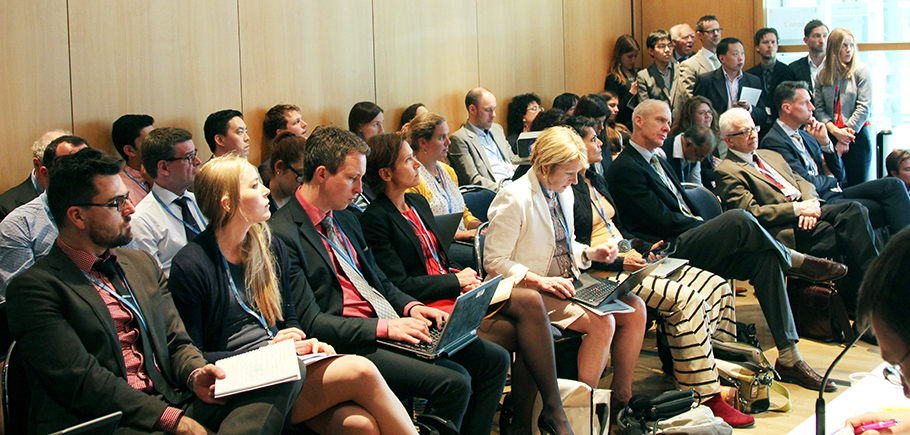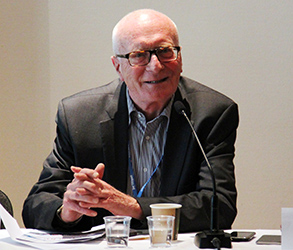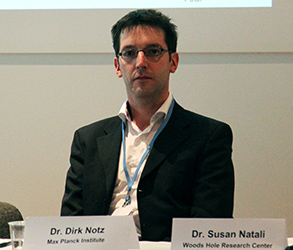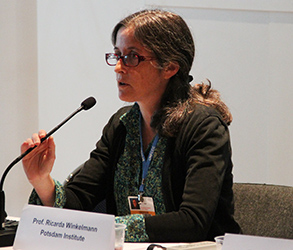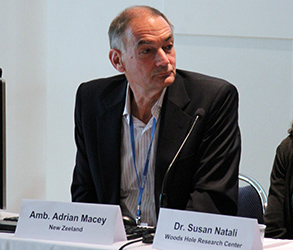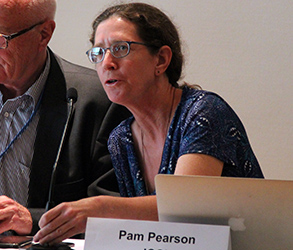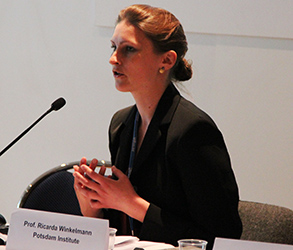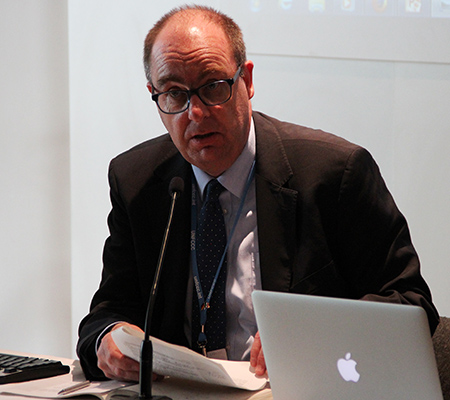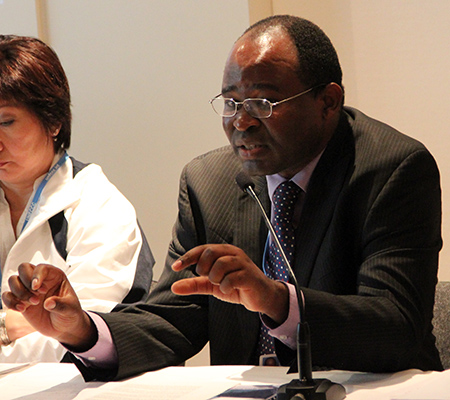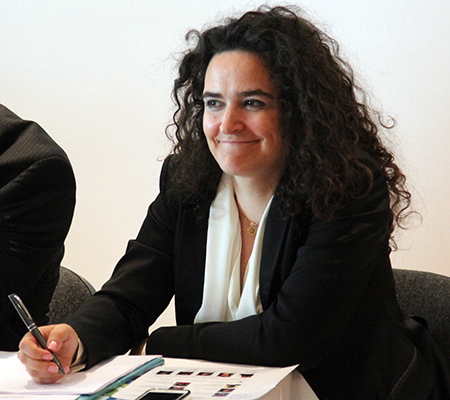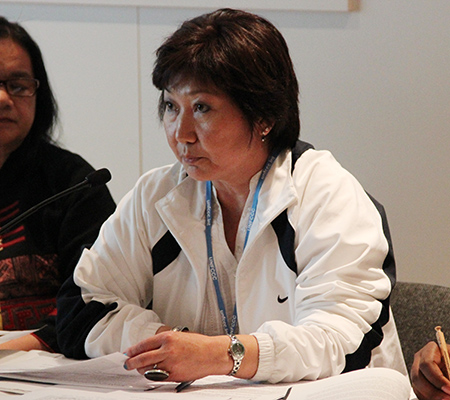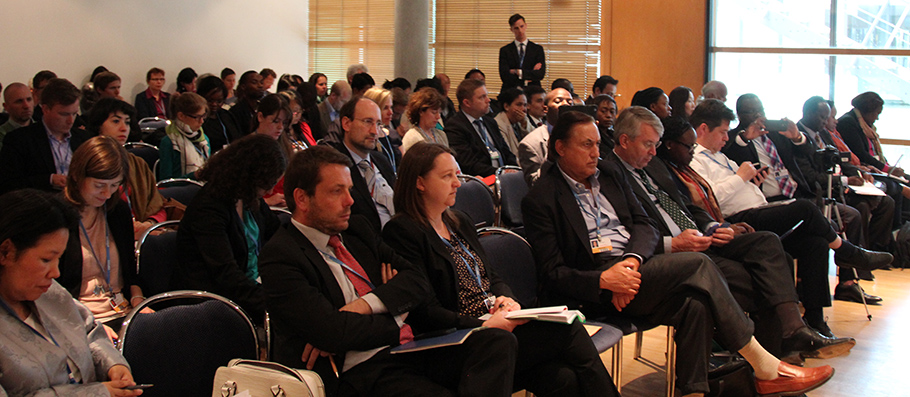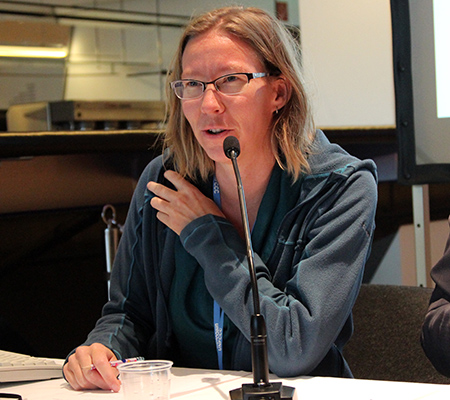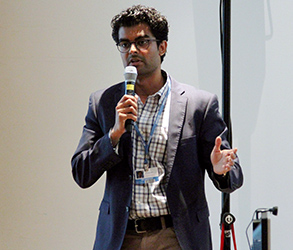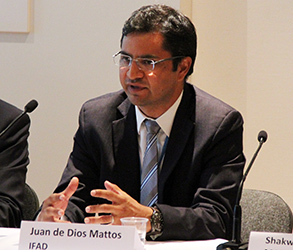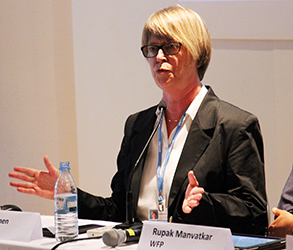Bonn Climate Change Conference - June 2015
1-11 June 2015 | Bonn, Germany
 |
 |
 |
Coverage of Selected Side Events at SBI 42, SBSTA 42 and ADP2-9
Highlights for Tuesday, 9 June 2015
Subscribe to our ENBOTS Reports |
||
|
Receive our ENBOTS bulletins and reports by email |
||

| Follow @IISDRS | ||

Loading... |
||
|
Receive emailed updates with the news articles above plus related information and announcements from our CLIMATE-L community mailing list: |
||
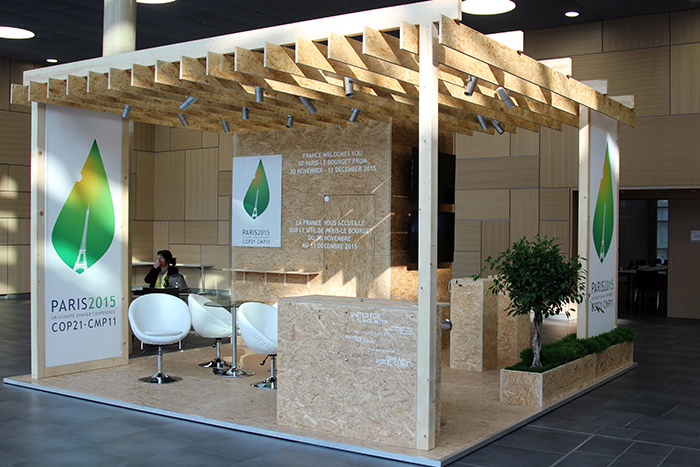
Paris 2015 COP21 booth |
||
|
The following side events were covered by ENBOTS on Tuesday, 9 June 2015. |
||
|
IISD Reporting Services, through its Earth Negotiations Bulletin on the Side (ENBOTS) Meeting Coverage, is providing daily digital coverage from selected side events at the Bonn Climate Change Conference - June 2015. | ||
Legal Issues in the Durban Platform Negotiations
Organized by the Center for Climate and Energy Solutions (C2ES)
|
This side event was moderated by Elliot Diringer. Noting that the Ad Hoc Working Group on the Durban Platform (ADP) and the UNFCCC Conference of the Parties (COP) have “tremendous” flexibility in designing and implementing the Paris agreement, Dan Bodansky, Arizona State University, put forward 10 propositions regarding legal issues surrounding the Paris agreement. He said COP decisions by themselves would not satisfy the legal force requirement of the Durban Mandate. He noted several bases for the COP to adopt a legal agreement, including: Article 7 (on the COP) , Article 15 (on amendments to the Convention), Article 16 (on adoption and amendments to annexes of the Convention), and Article 17 (on protocols) but noted the substantive limitations of Article 16 as it addresses annexes. He indicated that the COP would not have to specify under which article the Paris agreement was being adopted, and that the title of the Paris agreement was legally irrelevant. He said that while the legal nature of the Nationally Determined Contributions would depend on commitments contained in the agreement, the location where the contributions are housed would have “practical” implications such as the level of ease of updating them. He further noted that the term “adopt under the Convention” implied the possibility of having a different annex structure in the Paris agreement compared to the UNFCCC annexes. Discussant Sandea de Wet, South Africa, underscored that the scope of Intended Nationally Determined Contributions includes adaptation and called for greater thinking on how adaptation commitments would be reflected in the Paris agreement. Noting advantages of a legally binding instrument, Jake Werksman, European Commission, said the hybrid nature of the legal form that is emerging for the Paris agreement could be attributed to the wickedness of the problem of climate change and climate politics and the ratification dynamics of the “elephant in the room.” Pointing to the Gothenburg Protocol, which has commitments to implement and achieve outcomes on the abatement of acidification, eutrophication and ground-level ozone, Dean Bialek, Marshall Islands, urged exploring various possibilities for expressing specific commitments. He identified details on national contributions/commitments as an area needing further negotiation. Franz Perrez, Switzerland, noted a distinction between political and legal issues and said mixing them up would prevent parties from finding solutions. He underscored that the provisions of the agreement would determine the extent to which the commitments are legally binding (legal bindingness) and not necessarily where the commitments are placed. During discussions, Bodansky highlighted that the legal bindingness of an agreement had trade-offs with the extent of participation and the depth of commitments. Participants raised questions on inter alia: US participation; the timeframe of the new agreement; and the legal nature of COP decisions. | ||
|
|
||||
Cryosphere as a Lens for Paris: Science-based Urgency and Ambition
Organized by the International Cryosphere Climate Initiative (ICCI)
|
|
|
|
Moderator Pam Pearson, ICCI, introduced the session, underscoring the urgency of integrating impacts of the cryosphere into policymaking. Dirk Notz, Max Planck Institute for Meteorology, presented on the evolution of sea ice changes, noting summer sea ice coverage in the arctic has decreased by half in recent decades. He explained that increase in sea level ice in the Antarctic is due to wind changes, driven by increasing greenhouse gas (GHG) concentrations and the ozone hole, causing spread of ice over a greater area. He highlighted impacts of polar sea ice changes including an altering of the strength of the jet stream, which is causing extreme weather events outside of the poles. He stated that sea ice decrease is strongly correlated to CO2 concentration, meaning that future changes are in the hands of policymakers. Ricarda Winkelmann, Potsdam Institute for Climate Impact Research, presented her organization’s recent research on sea ice changes in “hot spots” of the Antarctic, noting the great potential of this ice “giant” to cause sea level rises up to 50 meters if East Antarctica melted completely. Highlighting self-enforcing feedback mechanisms, she noted that recent research shows that the Amundsen Basin in West Antarctica is likely to have already passed its tipping point, causing a sea-level rise of one meter. Susan Natali, Woods Hole Research Center, spoke on the effects of permafrost thaw on atmospheric carbon release. She noted that current emissions scenarios do not include the impact of permafrost carbon feedback, and highlighted “conservative” estimates that predict the release of 130-150 Gt of carbon by 2100, more than half of the carbon budget allowable to remain below the 2ºC pathway. She highlighted the importance of taking preventative action to avert thawing of permafrost, underscoring that once thawing occurs, carbon release cannot be stopped. Former Kyoto Protocol (KP) Chair, Harald Dovland, Norway, underscored the need to consider short-lived climate pollutants such as black carbon as well as CO2, noting the substantial health benefits that can be achieved by such reductions. Referring to discussions in the negotiations of the Ad Hoc Working Group on the Durban Platform for Enhanced Action, he said that the idea that adaptation could make up for shortfalls in mitigation was not true for the polar regions, concluding that significant mitigation is the only way forward. Former KP Chair, Amb. Adrian Macey, New Zealand, spoke on the need for better communication between the scientific community and policymakers, noting difficulties from both sides. He highlighted the need for clear, simplified communication, drawing attention to the recent progress made in this context in the Intergovernmental Panel on Climate Change’s Fifth Assessment Report. | ||
|
|
|
|
||||
Financing a Climate-Smart Future
Organized by the government of Zambia, Climate Investment Funds (CIF),
the European Bank for Reconstruction and Development (EBRD), and the UNFCCC
|
|
|
|
This session consisted of two panels which considered perspectives on the CIF results, and complementarity and coherence on climate finance. The panels were moderated by Jeff Brez, UN Department of Public Information, and Dechen Tsering, UNFCCC, respectively. David Kaluba, Zambia, spoke on the achievements of the CIF from the perspective of the Pilot Programme on Climate Resilience (PPCR), drawing attention to the mainstreaming of climate change into Zambia’s development planning processes; and the PPCR’s capacity development objective, which has lead to longer term investments in national- and local-level climate change policies and institutions. Grace Balawang, Tebtebba, spoke on the participation of civil society organizations and Indigenous Peoples in the CIF, highlighting the development of a dedicated grant mechanism for Indigenous Peoples financed by the CIF. She described setting up the governance system for the dedicated mechanism, noting that lessons can be learned from this experience on how to engage Indigenous Peoples in climate financing. | ||
|
|
|
|
||||
Global Research-Policy Interface Climate 2015
Organized by Climate Strategies and the Stanley Foundation
|
|
|
This event was moderated by Michael Grubb, University College London. Todd Edwards, the Stanley Foundation and Andrzej Blachowicz, Climate Strategies, highlighted their organizations’ works. Grubb provided an overview of the Global Climate Policy Conference 2015, held in New Delhi, India. He discussed results from two parallel sessions at the Conference: enhancing ambition through “club-type” approaches as opposed to universal participation; and adaptation and loss and damage. Noting that the Conference focused on applied research, he said it attempted to balance thematic interests across constituencies and noted a new narrative on carbon pricing and technology was emerging. Heleen de Coninck, University of Nijmegen, presented a hypothetical “club-based” model that would use carbon pricing, research and development, and international trade to encourage action on climate change by its members. She said the incentives for countries to join such a coalition would include: a desire to address climate change; preventing carbon leakage; having access to technology and setting up innovation systems; and benefits from trade arrangements that could make reluctant countries join the club. On the club model proposal, Grubb highlighted a few questions that had been raised, such as the ability of businesses and sub-national actors to participate, and the role of international trade in supporting the climate change agenda. On adaptation and loss and damage, Sonja Klinsky, Arizona State University, highlighted key questions raised on mainstreaming adaptation and assessing ongoing efforts on adaptation. Noting that research on adaptation tended to be in the form of case studies that highlight contextualized factors, she pointed to the need to develop systematic frameworks that can help identify salient factors across cases. On loss and damage, she highlighted developments in attribution studies and progress under the UNFCCC. Pointing to the use of probabilistic evidence to support the legal case of tobacco on the grounds of possible impacts, she highlighted event attribution as an area for further exploration in the legal work on loss and damage. Emmanuel Dlamini, Swaziland, noted the low demand for carbon trading given the scale of targets and commitments and highlighted the need to scale up small club arrangements into multilateral processes. During discussions, participants raised, inter alia: the design of trade rules to support innovative practices; supplementing multilateral negotiations with a club-based model; using lessons from adaptation to scale up REDD+ pilots; and building an adaptation framework that can be used by researchers. | ||
|
|
||||
Climate-Smart Agriculture (CSA) Advantage: Better Returns for Smallholders
Organized by the International Fund for Agricultural Development (IFAD)
|
|
Martin Frick, Climate, Energy and Tenure Division, Food and Agriculture Organization of the UN (FAO), moderated the event, explaining his organization’s move to climate-proof agriculture systems in order to eradicate hunger and address poverty. Juan de Dios Mattos, IFAD, described his organization’s work with governments and other stakeholders to reduce poverty and increase food security, describing CSA as a tool that increases smallholder farmers’ skills as well as increasing food production. He highlighted the Adaptation for Smallholder Agriculture Programme (ASAP), which aims to increase CSA. Describing work on the ground in Nicaragua and Bolivia, he underscored the importance of including a climate variable and an early warning system in development planning to enhance food security. Rupak Manvatkar, World Food Programme, spoke on the R4 Rural Resilience Initiative: risk reduction; risk transfer; prudent risk taking; and risk reserves, explaining that the Initiative enables farmers to invest in diversifying their agriculture practices and insure themselves against climate risk. He stressed that agriculture is relied upon by 75% of the 1.4 billion people in the world living on less than US$1.25 per day, and said safety nets should be flexible, scalable, measurable and time-effective. Kaisa Karttunen, FAO, spoke on working with farmers to identify and implement CSA, describing FAO work in Kenya, Tanzania, Ethiopia and China on rolling out this tool. She highlighted that CSA emphasizes local solutions with the aim of increasing food production while decreasing greenhouse gas emissions. She informed participants of an FAO tool, the self-evaluation and holistic assessment of climate resilience of farmers and pastoralists (SHARP), which enables farmers to assess their productivity while implementing CSA. Noting the role of the agricultural sector accounting for 24.1% of GDP, 30% of export earnings, 90.4% employment of working women, and 75% of the total workforce, Shakwaanande Natai, Ministry of Agriculture, Food Security and Cooperatives, Tanzania, spoke on implementing CSA in her country. She presented Tanzania’s 2014-2019 Agriculture Climate Resilience Plan, noting four priority resilience actions: improving agricultural land and water management; accelerating uptake of CSA; reducing impacts of climate shocks through improved risk management; and strengthening knowledge to target climate actions. In the discussion, participants considered, inter alia: youth participation in CSA; changing farmers’ mindsets to accept insurance schemes; and the need to engage political leaders in order to gain support for CSA. | ||
|
|
|
|
||||
|
The Earth Negotiations Bulletin on the side (ENBOTS) © <enb@iisd.org> is a special publication of the International Institute for Sustainable Development (IISD). This issue has been written by Rishikesh Ram Bhandary, Tallash Kantai and Gillian Nelson, Ph.D. The Digital Editor is Mike Muzurakis. The Editor is Dan Birchall <dan@iisd.org>. The Director of IISD Reporting Services is Langston James “Kimo” Goree VI <kimo@iisd.org>. Specific funding for coverage of side events through ENBOTS has been provided by the Kingdom of Saudi Arabia. The opinions expressed in ENBOTS are those of the authors and do not necessarily reflect the views of IISD and funders. Excerpts from ENBOTS may be used in non-commercial publications only with appropriate academic citation. For permission to use this material in commercial publications, contact the Director of IISD Reporting Services at <kimo@iisd.org>. Electronic versions of issues of ENBOTS from the Bonn Climate Change Conference - June 2015 can be found on the Linkages website at http://enb.iisd.org/climate/sb42/enbots/. The ENBOTS Team at the Bonn Climate Change Conference - June 2015 can be contacted by e-mail at <tallash@iisd.org>. | ||
has been provided by the Kingdom of Saudi Arabia and the European Union


IISD Reporting Services is grateful to the many donors of the Earth Negotiations Bulletin (ENB) and recognizes the following as core contributors to the ENB: the European Union, the Finnish Ministry for Foreign Affairs, the German Federal Ministry for the Environment, Nature Conservation, Building and Nuclear Safety (BMUB), the International Development Research Centre (IDRC), the Japanese Ministry of Environment (through the Institute for Global Environmental Strategies - IGES), the New Zealand Ministry of Foreign Affairs and Trade, the Kingdom of Saudi Arabia, SWAN International, Government of Switzerland (the Swiss Federal Office for the Environment (FOEN), the Swiss Agency for Development Cooperation (SDC), and the United Nations Environment Programme (UNEP). Funding for translation of the Bulletin into French is provided by the Government of France, the Wallonia, Québec, and the International Organization of La Francophonie/Institute for Sustainable Development of La Francophonie (IOF/IFDD).




